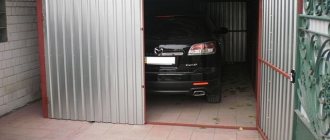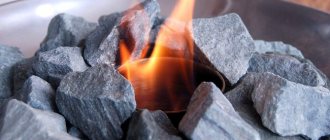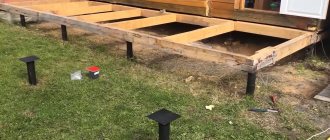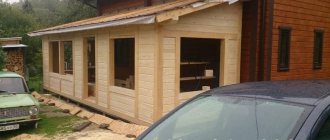A potbelly stove is often used to heat temporary buildings, garages, greenhouses, and utility rooms. But it also emits combustion products, a lot of smoke from burned wood or other fuels.
Therefore, you will need to decide how to make a chimney for a potbelly stove and where it is best to install it so that it is inexpensive and effective. Moreover, you can do it yourself. Moreover, everything is not as complicated as it might seem at first glance.
To make it easier for you to understand the assembly and installation of the chimney, in this article we looked at the step-by-step process, starting with the selection of material and assembly and ending with checking the functionality of the already installed system.
Content
Despite all the popularity of natural gas in the modern world, there are still places where its use is still unavailable. In this situation, a person will be helped by a stove in a wooden house, which is heated with wood fuel or coal. You can purchase this fuel at any time of the year.
Classic stove design
In appearance, the potbelly stove resembles an ordinary rectangle on legs. It is equipped with a door and a compartment for fuel, and an ash drawer for combustion waste. In addition, any potbelly stove is equipped with a branch pipe where an exhaust pipe with a length of 5 meters or more is installed. The length of the pipe directly affects the thrust and power of the device. The furnace body is made of steel or cast iron. We also recommend reading about the chimney for a potbelly stove in the garage on our portal.
Potbelly stoves are classified into two types:
- Metal devices.
- Brick buildings.
Brick models fit perfectly into a small country house and can heat several rooms at once. The stove heats the rooms evenly and allows you to retain heat for a long time. The only drawback of a brick potbelly stove is the long heating process. But the brick adds more functionality to the device; for example, during masonry, you can build a place for cooking. Craftsmen can arrange a recess for the oven.
Models of cast iron stoves are compact and easy to install, because they can be placed in any suitable place. The main thing is to fold the chimney correctly so that it can be easily moved thanks to the corrugated pipes.
Difficult climatic conditions are a factor that everyone living in the vast Russian territory has to take into account. With the onset of cold weather, houses, apartments, and industrial buildings are connected to centralized heating systems that supply heat and create comfortable conditions for us throughout the heating season.
Furnaces
Currently, there is a huge variety of types of ovens. The main advantage of a change house, from a heating point of view, is its limited area. With the correct design of the cabin (insulated block container), it is possible to organize full heating using low-power stoves.
In addition to power, the choice of stove is made based on criteria such as:
- Size;
- Fuel type;
- Chimney placement;
- Price;
- Operating costs (maintenance costs).
According to these criteria, the best option is a conventional wood-burning stove, such as a “potbelly stove”. They cost little, and fuel, if a successful combination of circumstances occurs, will be completely free. Operating costs are also minimal.
On the other hand, it is recommended to install such stoves in metal block containers, since an open fire in a wooden cabin can become a source of serious problems.
Installation
When choosing a change house, give preference to standardized options. In this case, it will be much easier for you to install the stove.
So, installation begins with determining the location of the furnace. It is advisable that this be a corner of the change house, since the stove should not interfere with the movement of people. However, the distance from the stove to the wall must be at least 300 mm. In addition, you should not place it near sleeping places, if any.
The stove must be installed on a base. Its function can be performed by a steel sheet on which bricks are laid. Thanks to this, the bottom of the cabin will not be exposed to excessive thermal effects, which will eliminate the risk of burnout.
The best option for a chimney is a vertical one, exiting through the ceiling of the cabin. However, you can also do it horizontally, if the design of the furnace implies this. In both cases, a hole will need to be cut for the chimney. It is recommended to protect the cut edges from external factors by edging them with thin strips of stainless steel.
If the chimney has connections, they must be sealed with special heat-resistant sealants.
Some tips
To ensure that your stove is installed correctly, consider purchasing a container unit with the stove already installed. Excellent cabins of this type are offered. Factory installation guarantees compliance with all technical standards and eliminates the risk of damaging your home during the process of removing the chimney.
It is advisable to fix metal sheets with a reflective surface on the walls closest to the stove - this will speed up the heating of the room.
You should not leave a burning stove unattended, especially when firing it “at night”: either warm up the room in advance, or organize a watch.
Systematically check the condition of the chimney: it must be sealed and free of blockages.
Naturally, the change house must provide for the possibility of quick evacuation.
Heating furnaces Properties of soapstone
Equipment characteristics
Recently, thanks to the variety of designs, potbelly stoves can complement the overall style of the interior of the room. Thus, this is not only a heating device, but also a kind of decoration for the room. The stove runs on wood no longer than 25 cm or other solid fuel, it all depends on the preferences of the owners and their financial capabilities.
The main functions of a potbelly stove installed in a country house:
- Heating.
- Possibility of cooking.
- Interior decoration.
Increasingly, a stylish potbelly stove is becoming a serious competitor for fireplaces, because, in addition to other positive qualities, the device is compact. It is easy to connect and, if necessary, move it to a new location or place it outside to fry meat in the fresh air.
A modern potbelly stove not only heats the room, but also decorates the room
If you need to frequently transport the stove from one place to another, then it is better to give preference to collapsible models. As a rule, they have an easily removable top cover, which often serves as a hob. This potbelly stove also features detachable legs and a multi-section chimney. The stove does not take up much free space, is a mobile piece of furniture and is easy to transport. Using a potbelly stove completely eliminates the risk of carbon monoxide poisoning, because it leaves the room through a pipe. It turns out that the safety of the device and the power of operation depend on the installation of the pipe.
Collapsible model of a potbelly stove
Design
The old models of “bourgeois” were not very diverse; designers did not pay any attention to them. Usually the owner of such a model himself came up with the appropriate design for it. He gave it a more attractive appearance and sought to improve its functionality.
Today you can use modern options that can decorate your interior. These include:
- art casting;
- colored glaze;
- overlays;
- heat-resistant paints.
Such models, in addition to their original external design, also differ in their shape. They can successfully replace a fireplace in the house. "Potbelly stove" will be able to repeat its classic form.
Potbelly stove for long-burning cottages - three simple options
- Piston stove. People call it the “Bubafonya” stove - most likely, this is the name of its creator. This is a top-burning stove, that is, wood is burned not from bottom to top, but, on the contrary, from top to bottom. Imagine a gas cylinder with the top cut off - firewood is loaded onto its bottom, which is pressed down from above by a piston. The piston has a hole for air flow - as combustion occurs, the piston moves down. The chimney in such a stove is located above the piston, and the wood gas released when wood burns is also burned above the piston. In general, the efficiency is very high, despite some inconveniences - it will not be possible to load additional firewood into such a stove during operation. It must burn out completely, and only after that it is recharged.
- Rocket stove potbelly stove. This is a very complicated stove, so I won’t even talk about its design. I will only say one thing - one load of such a stove burns out within an hour. This is despite the fact that its twisted hopper has a size of 120 by 120 mm - in fact, it works on wood chips.
- Do-it-yourself potbelly stove being worked on. A very simple, but unsafe potbelly stove - if water accidentally gets into it, it can result in a big boom. In addition, problems with fuel may arise - whatever one may say, used oil does not just lie around, and such potbelly stoves have quite a big appetite. The interesting thing about this potbelly stove is that the oil is burned directly in the fuel tank. In addition, when oil burns, a specific, not very pleasant smell is released (firewood smells more pleasant).
This is how things stand with the solution to the question of how to make a potbelly stove with your own hands? As you can see, there is plenty to choose from, despite the fact that this choice is not always easy to make. If this is your first potbelly stove, then, naturally, it is better to start with something simple and move up. Ask which potbelly stove is best? In my opinion, the most interesting and effective is the rocket stove - it is the one that produces the maximum amount of heat with a minimum fuel load.
Required materials and tools
To make a heating device, the following tools will be useful:
- Bulgarian;
- welding machine;
- sledgehammer;
- sandpaper;
- chisel;
- centimeter tape, marker;
- hammer drill
To make a potbelly stove, improvised materials are often used. This could be an empty gas cylinder, a metal barrel, or a milk cylinder. A simple option is to lay the device out of brick.
Potbelly stove made from a gas cylinder, vertical design
By and large, such a potbelly stove is not much different from the option described above - the difference lies only in the location of the cylinder, which has its own advantages.
- First of all, a potbelly stove is more compact and takes up less space in the room.
- This design allows you to install convective pipes of greater length, which will have a better effect on the process of heat distribution in the house. In addition, with this design of the potbelly stove, the convective pipes will not need to be bent.
A vertical potbelly stove also has its drawbacks - first of all, it is a short combustion chamber, limited by the diameter of the pipe used for its manufacture (or the diameter of the cylinder). At a minimum, this is a limitation on the length of firewood - they may have to be cut additionally. It is much more difficult to attach a burner to such a potbelly stove. And the third, most important point is the direct flow of the furnace. In fact, the flame in it is thrown directly into the chimney. This issue can be resolved, but it complicates the design. As a rule, the combustion chamber is attached to the side of such furnaces. In all other respects, it is the same design and, accordingly, all the same components.
Garage chimney maintenance
The rules for caring for a garage chimney are the same as for any other chimney.
The system must be inspected at least once a year to see if it is damaged.
It is also advisable to clean the chimney 1-2 times a year. To do this, you can use chemicals (a special log that is burned in a potbelly stove, and whose smoke decomposes the layered soot). But it is better to use a brush. It will be easiest to clean the pipe with a brush if you install a tee in it with a removable condensate collector (the collector is removed and the chimney is cleaned through the opened hole).
Rules and methods for lining a chimney: comparison and step-by-step work
Let's rationalize heating: how to use a heat exchanger on a chimney, and how is it useful?
Related Posts
Firebox of the new furnace
In the morning after installing the stove, it was decided to check its capacity. The entire firebox was not filled with firewood, only small ¼ was added. The logs were made of birch and aspen. After the wood was in the firebox and set on fire, smoke began to emerge—probably the paint was burning through. During the entire burning period, work was carried out at maximum capacity; later I wanted to ventilate the room. The entire incomplete stack burned out in 30 minutes.
What we have:
After there were a few red coals left in the stove, it was decided to add another portion of firewood. The floor under the stove became very hot, you can touch it, but you cannot hold it with your hand. The wall behind the stove, opposite the stove, is hot, but you can hold your hand for a couple of seconds.
Sandwich too - you can hold it for a few seconds. Then, for an hour and a half, the firebox continued in the long-burning mode.
After the first fire, the temperature in the room was +22 degrees, after the second - +25.
After the first fire, it was possible to say that the stove worked well and I really liked it, the power adjustments were simple, but at first it was not clear how the glass blowing worked.
The glass remained clean after operation of the firebox. After finishing the fire, two hours later the stove was quite warm. I won’t argue about the heat capacity comparable to brick stoves; one must demand from each heating device what it can give, and receive from it what it is designed for. We can conclude that Chinese-made cast iron stoves are very functional in operation and give impressive results.
A short historical excursion
Initially, a “potbelly stove” was a name given to a steel stove of a certain design, the creation of which took place during the dramatic years of the Civil War for our country. It is not known exactly which of the Russian engineers came up with a very simple, but very effective steel furnace, relatively easily made in a handicraft way from more or less available materials. During the times of “war communism”, after the urban economy with centralized heating in large cities collapsed, this tiny stove, which could be installed almost anywhere in a “bourgeois” apartment densely packed with house committees, saved many lives. By the way, the statement that the stove got its name due to excessive consumption of firewood is a stupid legend born on the Internet. In fact, the potbelly stove is very economical for its type. In conditions of a severe shortage of coal and firewood, the owner of a walnut set by master Gumbs had the opportunity to survive a terrible winter, using the precious furniture as firewood. The name of the furnace was determined by the fact that at first it became widespread among “former” engineers, office workers, and intellectuals who did not emigrate from the country. That is, according to the concepts of the proletariat, “bourgeois”.
How to install a potbelly stove in the country
When installing a potbelly stove, remember that the metal body heats up quite quickly. Stainless steel ovens heat up less and cool down faster. Potbelly stoves, which are made of cast iron, will retain heat much longer, so they must be installed in such a way that they are visible during operation and for some time after the flame has died out.
If you install potbelly stoves on metal legs, you must remember that these auxiliary structures will also heat up. The heating temperature will be lower than that of the case, but still not too low. To install potbelly stoves in your dacha, you will need to install them on a fireproof base. In this case you can use:
Scheme of a potbelly stove stove.
- tin products;
- concrete structures;
- ceramic tile products;
- brickwork.
Fire hazardous grounds are:
- those made of plastic of any kind;
- plank or parquet floors;
- laminate bases;
- linoleum bases;
- It is not allowed to use carpet or other soft coverings.
If the house has wooden walls or panels, the stove must be installed at a distance of 1 m from them. Chimney pipes in the room are installed from 1 section, without the use of connections. If for some reason this cannot be done, you need to make a tight connection, and one section must necessarily fit into the other. If the pipe passes through the wall, you will need to make a thermal barrier from ceramics or brick. In this case, concrete can also be used, but it will crumble when temperature changes.
The fuel storage container will need to be placed next to the door to prevent sparks from entering it.
Diagram of a potbelly stove with dimensions.
Quite often, potbelly stoves in the country are used not only to provide heating. There are a large number of designs that combine several functions. Such designs include a heating stove with a cast iron stove. They can be used for cooking and at the same time for heating a country house. A household cast iron stove with 1 burner can easily replace a gas or electric stove in the country. If there is a need to feed several people at one time, you should make or purchase a stove with a continuous cooking surface or with 2-4 burners.
Ovens that have a water tank are also popular. Their design is similar to a samovar. A water container is mounted around a wood-burning cast iron stove.
How to make a potbelly stove with your own hands - potbelly stove device
It couldn’t be simpler - this is how you can describe a potbelly stove, the history of which goes back several centuries. To exaggerate, in order to build a primitive potbelly stove yourself, you will need a metal box and a pipe. We weld everything together, load the firewood and enjoy the warmth. Yes, it's not safe. Yes, it is inconvenient and, most importantly, not very effective - that is why a modern potbelly stove has a number of additions.
- As in any other solid fuel stove, grates are installed in it, under which an ash pan is made.
- Like all other stoves, a potbelly stove has doors for loading fuel and removing combustion products.
- A chimney, without which the stove turns into an ordinary fire pit.
- Bulkheads are also built inside, the task of which is to retain the maximum amount of heat inside the room.
You can see what homemade potbelly stoves look like in this short video.
In addition, many modern potbelly stoves for dachas are equipped with convection pipes (they are needed for more efficient heating of the air in the room) and various devices for cooking. Burners on which you can warm tea and, if necessary, fry potatoes with lard and onions.
General recommendations for installing a potbelly stove with your own hands
Chimney installation diagram for a potbelly stove.
It is necessary to first familiarize yourself with some information about the installation of such a structure in order to know what nuances you will have to face.
You can install a potbelly stove if you have basic construction skills and learning abilities.
The main problem for heating equipment that runs on wood is installing a chimney system. A potbelly stove has simplified requirements when compared with a fireplace. In this case, it is not necessary to make a vertical chimney.
For fire safety purposes, a potbelly stove requires an insulation layer. To do this, you need to make a brick platform or use a stainless steel sheet. You can also use asbestos-cement sheet, which is galvanized. This design can withstand temperatures up to +400°C.
It is allowed to use metal legs to install the stove. This design can save building materials and your own effort, which can be spent on installing the stove.
Scheme of a potbelly stove with a heat exchanger.
It is necessary to retreat 80 cm from the wall or add a thermal insulation layer to the wall. It is also recommended to install a protective coating around the perimeter of the stove, which can prevent fire if sparks hit the floor.
The chimney can be brought out at an angle from the wall. In this case, it is necessary to take care of the tight connection of the sections of the chimney structure. In most cases, a sandwich structure is used, which has a high level of safety due to the fact that the chimney pipe is partially insulated in the structure. It is not allowed to use thin stainless steel for the chimney structure, because it will quickly burn out. The pipe must be led outside through a drilled hole in the wall or roof. At the end, the resulting cracks must be covered with clay.
In order to be able to regulate the draft, it is necessary to purchase a damper, which is installed in the chimney structure and can block it completely or partially, if necessary. The gate will be needed a few mm smaller than the pipe diameter. You need to make 2 holes in the pipe. Next, you should thread a rod into them, to which the gate is attached.
The walls next to the stove must be protected with a steel screen or lined with ceramic tiles. It is preferable to use the latter option.
At the end, cosmetic work is carried out, which consists of filling up the cracks and improving the area on which it is planned to place the potbelly stove.
How is a chimney installed?
To install a chimney, the following materials are needed:
- elbow 1200x100 mm;
- 2 elbows 1200x160 mm;
- 3 butt elbows;
- tee;
- stub;
- fungus.
Thermal insulating material and a passage glass may be useful for installing a chimney. To seal the seams, sealant or asbestos cord is used.
The chimney installation process is as follows:
- It is necessary to fix 1 piece of pipe at the chimney opening.
- Pipe elbows will need to be extended to the ceiling line.
- A hole with a diameter of 170 mm or more must be made in the ceiling. In places where the chimney pipe must pass through the ceilings, you will need to remove the insulating layer. This is necessary in order to exclude the possibility of ignition of this layer.
- It is necessary to insert a passage glass into the hole that was made, and then pass the chimney pipe through it.
- Next, the pipe is connected to the external chimney structure.
- A layer of bitumen is applied to the outer part of the pipe. All this is wrapped in thermal insulation material.
https://youtube.com/watch?v=SMVD6li2QI4
Installing a potbelly stove is quite simple if you know all the nuances and have all the tools.
Ceiling passage
To allow the sandwich to pass through the ceiling, a rectangular hole was cut to the size of the stainless ceiling cutout. An SML slab 8 mm thick and 60x60 cm in size was laid for cutting. This entire structure was screwed with self-tapping screws to the bars in the ceiling between the floors. In the ceiling around the pipe, insulation with foil two layers thick was laid, the foil was laid towards the sandwich. I taped all the seams with aluminum self-adhesive tape and covered the top with the same LSU sheet measuring 60x60 cm. The roof passage has not yet been laid in any way, because it is planned to redo the roof next year. Masterflash was placed on top and sealed with sealant.
Self-installation of a potbelly stove
When choosing a stove option for a country house, it is important to carefully calculate the required power for heating the selected area. A potbelly stove with an area of 1 sq.m can heat a room of 35 sq.m.
When choosing a stove for a country house, it is important to carefully calculate the required power for heating the selected area
An important factor in the operation of the device is the blowing of heat out of the room and the influx of cold air into it. For example, cracks in windows or floors that create a draft will noticeably disrupt the operation of the potbelly stove. An excellent solution for a two-story country house is a two-tier potbelly stove with a common chimney. Read more about installing a homemade potbelly stove in a country house on our website.
Video: installation of a potbelly stove and chimney
If you want to reduce the cost of installing and purchasing a stove, you can try to make it yourself according to the instructions.
Self-assembly of a potbelly stove
Fire safety standards for installation and operation of the stove
In order to protect your home if you have a stove, you should follow some fire safety rules:
- Use only dry firewood or logs as fuel.
- To ignite the device, open the firebox damper slightly and put the required amount of fuel there, and then set it on fire.
- When the fuel is sufficiently hot, the power of the stove can be adjusted by opening and closing the ash drawer.
- To clean the potbelly stove from ash, you need to completely cool the body, remove the ash drawer and throw away its contents.
To clean the potbelly stove from ash, you need to cool the body, remove the ash drawer and throw away the garbage from it.
When you first ignite, you may smell burning paint, but this effect will not happen again later. Any flammable items must be kept at least 80 cm away from the stove. It is prohibited to place more than 3 kg of fuel into the firebox at one time.
It is important to always close the firebox door. It is prohibited to use the stove if a malfunction is detected in the functioning of the exhaust pipe. It is forbidden to leave the potbelly stove unattended for a long time and in the presence of small children. When the oven is operating, you should not touch its body, as it heats up to a very high temperature. It is prohibited to place flammable materials near the stove. The stove can only be installed on a non-combustible base.
You can install a potbelly stove in a wooden house only on a non-combustible base
Potbelly stove for a summer residence, horizontal version
This is perhaps the easiest option for making it yourself. Like all stoves of this type, at home they are created either from a large diameter pipe or from a propane cylinder, which is much better. You can make such a potbelly stove as follows.
- First you need to open the cylinder - this is a dangerous matter. First you need to unscrew or beat off the tap with a sledgehammer - first, the contents of the cylinder are vented to the maximum, and the condensate is drained. Then the container is filled with water and only then can you cut.
- First, one of its rounded parts is cut off (where the tap was). After it is cut off, the water can be drained and you can work with the cylinder without fear.
- We attach legs to the balloon and install it horizontally.
- On the blind side (top) we cut a round hole with a diameter of 100 mm and weld a pipe of the same diameter to it - this is a chimney. The length of the pipe is about a meter - everything else is built up later.
- Now inside the balloon. At the very top you need to attach a strip of thick metal - this is a flame stopper that will protect the body of the potbelly stove from burning out. If the plate burns out, it is easy to replace. By the way, it should not block the chimney.
- Grate bars. The easiest way to weld them is from thick reinforcement - a kind of grille that is inserted into the lower part of the cylinder and secured there by any available means. It would be better, of course, if it were a removable product.
- And the last point is the door, or rather two doors: the ash pan and the firebox must open and close separately from each other. The ash pan, as in many furnaces (or rather, its door) additionally works with an air flow, with the help of which it will be possible to regulate the rate of fuel combustion.
This design can be supplemented with convectors - pipes through which air from the room will pass and be heated. They are simply welded vertically to the side of the potbelly stove - ideally, the pipes should be bent so that they follow the contours of the stove. In addition, you can additionally weld a plate on top of the cylinder, which will serve as a kind of burner - alternatively, you can cut another hole in the top of the cylinder itself and weld the plate on top of it. Such a burner will work much more efficiently.
What pipes should I use? (+assembly video)
It is impossible to build a brick chimney in a garage; asbestos and ceramic ones are difficult to use.
Therefore, there are 2 options left:
- Stainless steel pipe.
- Stainless steel corrugation.
Corrugation can and is conveniently used to lay the inside of the chimney (which runs inside the garage). It can be carried out all the way to the tee near the wall or ceiling.
Stainless steel pipe - can be used both for the external (street) part and for the internal part. Working with it is a little more difficult: since it cannot be bent, each turn will have to be connected to a bend. But the stainless steel pipe is smooth inside, and the corrugation is ribbed (which means soot will accumulate).
Let's summarize: the simplest and cheapest option is corrugation inside, then a tee, then a stainless steel pipe outside. The option is more convenient (to maintain), but a little more difficult to install - a stainless pipe both inside and outside.











